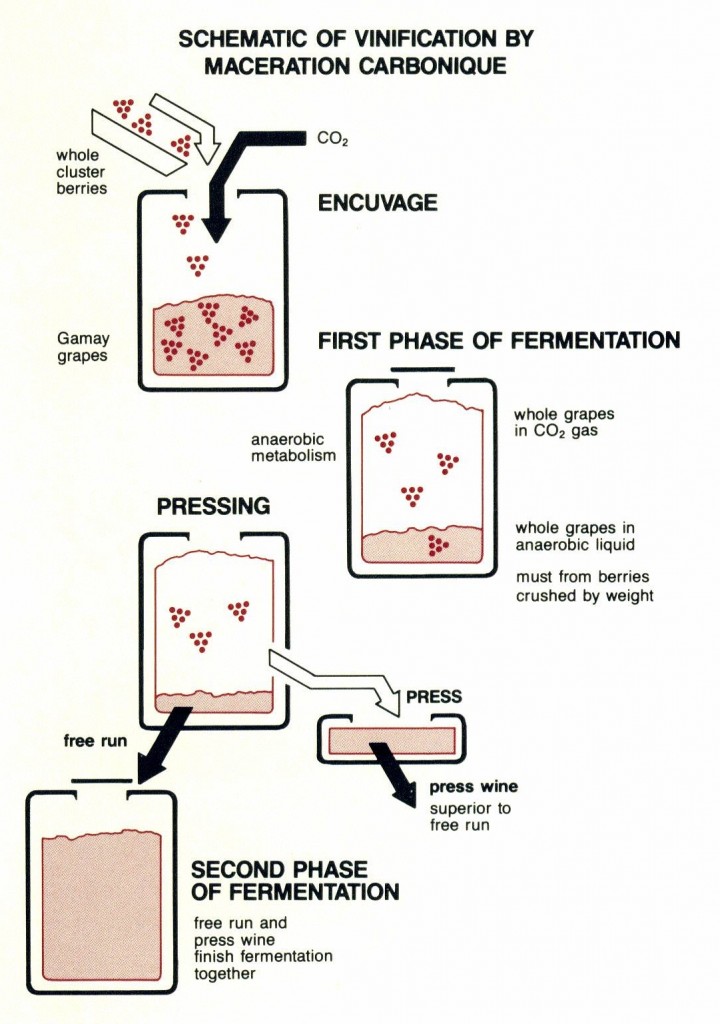You know the deal; the more some folks learn about a topic, the more shortcuts/slang/acronyms/initials/technical jargon can be tossed around. I’m here to help you understand those sometimes mysterious words and phrases, thus – Wine Words Demystified! This week’s term is Carbonic Maceration...
According to Wikipedia…
Carbonic maceration is a winemaking technique, often associated with the French wine region of Beaujolais, in which whole grapes are fermented in a carbon dioxide rich environment prior to crushing.
In other words, it’s a technique for making light, fresh, fruity wines.
I became interested in the term, which I knew next to nothing about, after I read the following backgrounder on the 2013 Bedrock Wine Co. Grenache Gris Gibson Ranch…
I have long wanted to make a light, summer, red—a California version of Beaujolais or Pinot D’Aunis or Frappato, but perhaps kissed with just a trace more sunshine. Something fresh, juicy, spicy, and delicious. This fits that description. It was fermented with 50% whole-cluster with no foot-trodding to maximize carbonic fermentation with the rest destemmed…
How it’s different
In most red grape traditional winemaking styles, grapes are crushed and fermented for ten to twenty days, then pressed and aged for six months to two years in wood before bottling.
In carbonic maceration, grapes are placed as whole clusters (or as in the case of the Bedrock half were whole cluster and the other half were destemmed) into temperature controlled steel or concrete fermentation tanks, which are then sealed and pumped full of carbon dioxide. The bottom one-third of the grape clusters are crushed by the sheer weight of the grape mass, and these undergo traditional fermentation by way of the natural yeasts that exist on the skins of the grapes which convert the grape sugars into alcohol. The overlying two-thirds of the grape clusters are converted into alcohol by way of carbonic maceration. The carbon dioxide in the containers creates an anaerobic environment which then allows the carbon dioxide to permeate the intact grape skins. The entire process takes place inside each single, intact berry at an intracellular level. The entire process is shorter than conventional fermentation (it usually takes four to five days), and The resulting wine is fruity with very low tannins.
Pure carbonic maceration is rare. Most carbonic fermentation is actually semi or partial carbonic maceration because it involves a combination of carbonic and conventional fermentation. There are other variations on the theme as well. For example, as mentioned for the wine above, half the grapes processed were whole clusters and half were destemmed.
And that wine mentioned above? Mission accomplished – it’s a chillable red wine that’s fresh, juicy, spicy, and delicious!
__________________________________________________________________
Martin Redmond is a Financial Executive by day, and a certified wine geek with latent foodie tendencies the rest of the time. In addition to the wine lifestyle and food he enjoys family, fitness and traveling. He likes to get thoughts of wine off his mind by sharing experiences on his ENOFYLZ Wine blog, which features wine reviews, wine country travel, and wine and food pairings.
Follow me on Twitter @martindredmond for all things wine, and since I’m a wino, with latent foodie tendencies, you’ll also find food and wine pairings, and food related stuff! Become a fan and join ENOFYLZ Wine Blog on Facebook. Cheers!
This article is original to ENOFYLZ Wine Blog.com. Copyright 2014 ENOFYLZ Wine Blog. All rights reserved.
Spread the love!, Share this post
Like this:
Like Loading...
